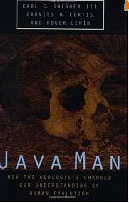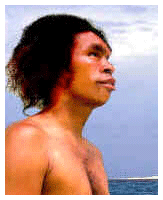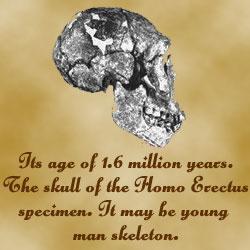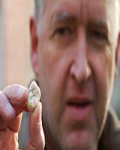- Latest Archaeology Updates
- Importance and applicability
- Famous Archaeologists
- Museums Collections
- Site Map
- World Heritage Sites
- World History Monuments
- Archaeological Organizations
- World Atlas of Archaeology
- Forensic Investigation and Geophysics
- Contact Us
- Movies based on Archaeology
- Frequently Asked Questions
- Archaeological discoveries
- Tell a Friend
- Archaeological Abbreviations
- Gallery Collections
- Famous-Museums site map
- Famous-archaeologists site map
- Archaeological Monuments site map
Java Man is an extinct species of Homo erectus (previously known as Pithecanthropus erectus) that lived in Indonesia during the Pleistocene epoch. It was first discovered in 1891 by Dutch anatomist and geologist Eugène Dubois while he was excavating a site near the Solo River in East Java. Java Man is the namesake of the Homo erectus species, which is believed to be the direct ancestor of modern humans.
The remains of Java Man consist of a skullcap, a femur, three teeth, and a molar. The skullcap was the first to be discovered and is the most complete, showing a robust cranial vault with a low forehead and well-defined brow ridges. The femur is the most complete long bone belonging to a Homo erectus specimen, providing evidence of a modern human-like gait. The teeth and molar are smaller than those of modern humans, indicating a smaller jaw and face.
Java Man is estimated to have lived approximately 1.6 million years ago, making it one of the oldest known human ancestors. The remains have been studied extensively and have provided insight into the evolution of the Homo erectus species, as well as the origin of modern humans. In addition, the discovery of Java Man has helped to shed light on the early migration patterns of our ancestors and the dispersal of Homo erectus throughout Asia and Europe.
Other Skulls Found
- The skull of Java Man is a fossilized skull of Homo erectus found on the island of Java in 1891 by Dutch anatomist and geologist Eugene Dubois.
- The skull, which Dubois named Pithecanthropus erectus, was the first of its kind discovered, and it provided the first evidence that humans had evolved from earlier primates. It is now considered to be an example of Homo erectus, a direct ancestor of modern humans. The skull is housed in the Naturalis Biodiversity Center in Leiden, Netherlands.
- The skull is very large, measuring 22 cm (8.7 in) in length and 17 cm (6.7 in) in width, and has a brain capacity of approximately 1,000 cubic centimeters. It is heavily worn, with most of the mandible missing, and has been reconstructed with plaster and wax.
- The left side of the face is well-preserved, showing a protruding brow ridge, a large nose, and a wide jaw. The eye sockets are deep and the cheekbones are prominent.
- The significance of Java Man lies in the fact that it was the first fossil evidence for human evolution, and the first evidence for the existence of Homo erectus. It was also the first fossil to be found outside of Europe and North America, providing evidence for the idea of human evolution across different regions.
- Java Man is an important part of the history of paleoanthropology, and its discovery spurred further exploration and research into human evolution.
An Icon of Early Human Development: Java Man
Java Man is an early human ancestor that dates back to the Pleistocene Epoch. It was discovered in Indonesia in 1891 by Dutch anatomist Eugene Dubois. The discovery of Java Man was the first evidence of an early human ancestor and was a major breakthrough in the study of human evolution.
Java Man was found in the Solo River valley on the island of Java in Indonesia. Dubois uncovered a skullcap, a femur (thighbone), and three molar teeth which he believed to be from a single individual. Dubois initially called the creature Pithecanthropus erectus, which translates to "upright ape-man". Later, this species was reclassified as Homo erectus and is now thought to be a direct ancestor of modern humans.
The skullcap of Java Man is the most complete fossil of an early human ancestor ever found. It is very similar to a modern human skull, with a wide forehead, bulging brows, and a large brain capacity. The femur is also very similar to a modern human's, indicating that the creature was bipedal and had a human-like posture. The molars are also very similar to those of modern humans, indicating that the creature was omnivorous and ate a variety of foods.
Java Man is an important discovery for understanding early human development. It provides evidence of a species of early humans that existed before the emergence of Homo sapiens\.
It also indicates that Homo erectus may have been the direct ancestor of modern humans, confirming the Out of Africa Theory. The discovery of Java Man also provided evidence that humans evolved in Asia, not Africa.
Illuminating the Mysteries of Java Man :
- Java Man is the name given to a hominin fossil found in the early 20th century on the Indonesian island of Java. It consists of a skullcap, a molar, and a femur, and is estimated to be between 1.7 and 1.9 million years old. It was discovered by Eugene Dubois in 1891, who spent the next several years excavating the site and looking for more specimens.
- Dubois initially thought that the fossil was that of a primitive human, but later reclassified it as Homo erectus. This classification has been accepted by the scientific community, as Java Man has been determined to have a number of primitive characteristics, such as a large brain and a large face.
- Java Man is significant because it is one of the earliest known hominins, and it helps to bridge the gap between earlier hominins and modern humans. Java Man also provides important evidence for the evolution of humans, as it shows that early hominins were capable of toolmaking, fire use, and other advanced behaviors.
- Java Man also helps to shed light on the migration of early humans out of Africa. It is believed that Java Man is descended from Homo erectus populations that migrated out of Africa and into Asia, eventually settling in the area of Java. This journey may have taken place as early as 1.7 million years ago, and it is a significant part of the human story.
- Java Man is also important because it provides evidence of past climate conditions in Java. Analysis of the fossil indicates that the environment in which Java Man lived was likely much wetter than it is today, suggesting that the island may have been covered in forests and othervegetation . This provides an important glimpse into the environmental conditions of the past.
- Java Man is significant because it provides evidence for the interbreeding of early human species. Analysis of the fossil suggests that it is a hybrid of Homo erectus and Homo sapiens, indicating that the two species interbred in the distant past. This provides important evidence for the interbreeding of species, and it helps to explain why modern humans are so diverse.

Java Man: Written by Carl C. Swisher III
By uncovering new evidence about the hominid known as Java man.

The Fossil Trail:Written by Ian Tattersall.
This volume is an informal account of the known paleoanthropological discoveries and associated historical information up to 1995.

Extinct Humans: Written by IAN TATTERSALL and JEFFREY H. SCHWARTZ
Scientists have long envisioned the human “family tree” as a straight-line progression from the apelike australopithecines to the enigmatic Homo habilis to the famous Neanderthals, culminating in us, Homo sapiens.
Rich Resources on Java Man
Discovered by Eugene Dubois in 1891 near Trinil in Java. This find consisted of a flat, very thick skullcap, a few teeth, and a thigh bone found about 12 meters away (Theunissen, 1989).
In 1892 on the island of Java, he found a thigh-bone, which to all intents and purposes was like that of modern humans.
Amesbury Archer (or King of Stonehenge) is an early Bronze Age man, dating to around 2300 BC. His grave is of particular importance because of the rich valuables and the earliest gold objects ever found in England.
Otzi the Iceman is well naturally preserved mummy of a man. The man who was been captured in Ice was believed to be over 53 centuries old (3300 BC).
Java man is an interesting discovery to note that the find was not a complete specimen, but consisted merely of a skullcap, a femur, and three teeth. Many scientists of the day even suggested that Dubois' Java Man might have been the so-called "missing link
Kennewick Man is the name for the remains of a prehistoric man found on a bank of the Columbia River near Kennewick, Washington, on July 28, 1996. The Kennewick Man news story is one of the most significant archaeology stories of contemporary times.
Neandertal1 or Neanderthal was a species of genus Homo (Homo neanderthalensis) that inhabited Europe and parts of western Asia during the last ice age.
Peking Man (sometimes now called Beijing Man), also called Sinanthropus pekinensis (currently Homo erectus pekinensis), is an example of Homo erectus.
The Red Lady of Paviland is a fairly complete Upper Paleolithic-era human male skeleton dyed in red ochre, discovered in 1823 by Rev. William Buckland in one of the Paviland limestone caves of the Gower Peninsula in south Wales, dating from c29,000.
The Tollund man lived during the late 5th century BC and/or early 4th century BC, about 2,400 years . He was buried in a peat bog on the Jutland Peninsula in Denmark, a find known as a bog body.
Turkana Boy, the designation given to fossil KNM-WT (Kenya National Museum-West Turkana), is a nearly complete skeleton of a 12-year-old hominid boy who died 1.6 million years ago.Turkana Boy is classified as either Homo erectus or Homo ergaster.
The Dead Sea Scrolls are a collection of about 850 documents, including texts from the Hebrew Bible, which were discovered in eleven caves near Qumran, in a fortress northwest of the Dead Sea in Israel.
The Narmer Palette, or Great Hierakonpolis Palette, is a significant Egyptian archeological find, dating from about 3200 BC, containing some of the earliest hieroglyphic inscriptions ever found, and depicting the unification of Upper and Lower Egypt under Narmer.
Rosetta Stone is a dark granite stone (often incorrectly identified as "basalt") which provided modern researchers with translations of ancient text in Egyptian demotic script, Greek, and Egyptian hieroglyphics.
Linear B is the script that was used for writing Mycenaean, an early form of the Greek language. It occurrs primarily on tablets dated from the 14th and 13th centuries BC.
The Sweet Track is an ancient roadway in the Somerset Levels, England. As of the early 2000s, it is the oldest known engineered roadway in the world. An grand footpath that ran for almost 2km across the Somerset levels swamps.
Tautavel Man is an ancestor of Neanderthal man, was slightly different from his contemporaries living Asia and Africa. In the village of Tautavel is located in the South of France, one of the most ancient humans was found: the Tautavel Man.
The Galilee Boat which is also referred as the "Jesus Boat" was found by local Galilean inhabitants in January 1986. The boat was wrapped in a polyurethane shell and then immersed in a special tank of water to avoid quick disintegration.
The monumental Ekron inscription is dated, statistically and historically, to the first half of the seventh century B.C.E. The five lines of the inscription are together with this in a slit open border.
It wasn't long back when a lot of scholars were quizzical the real survival of a Roman Governor with the name Pontius Pilate, the procurator who ordered Jesus' crucifixion. In June 1961 close to Caesarea-on-the-Sea (Maritima) was unearthed this appealing limestone block.
In 1990 ornately decorate limestone ossuary (bone depository) was found in Jerusalem's Peace Forest. In the ossuary were the bones of two babies, a adolescent child, a teenage boy, an adult woman, and a man about 60years of age.
In biblical Israel, papyrus was the main form of writing substance. Once an authorized deed was written, it would be rolled up, one end crinkled in one-third of the width and the contrary end likewise folded in.
It is the Capital city of a prehistoric principality in what these days is on the northern part of the Syrian coast, just north of the city of Latakia.




